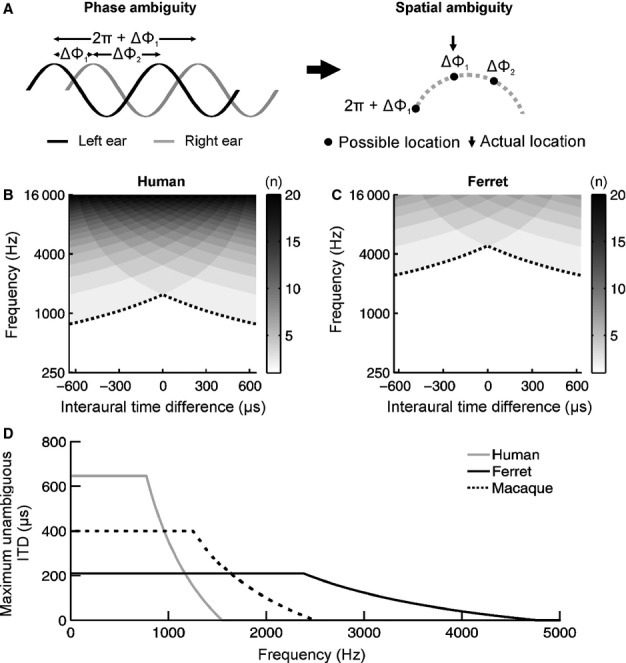Fig. 3.

Phase ambiguity is produced by an interaction between ITD magnitude and sound frequency. (A) Phase ambiguity occurs because it is unclear whether the waveform in the right ear (grey) is delayed (ΔΦ1) or advanced (ΔΦ2) with respect to the waveform in the left ear (black). Assuming that the waveform is delayed in the right ear, it is also difficult to distinguish between a particular IPD (ΔΦ1) and other IPDs that differ either by a full period of the waveform (ΔΦ1 + 2π) or multiples thereof (i.e. ΔΦ1 + n2π). Spatial ambiguity can therefore occur whenever the IPD is consistent with more than one ITD in the physiological range. (B, C) For each combination of sound frequency and ITD, we determined the number of physiologically plausible ITDs corresponding to a single IPD (i.e. we measured the degree of spatial ambiguity). Where this value is equal to one (white region), this means that a particular combination of sound frequency and ITD is unambiguous. Values > 1 (grey) denote combinations of frequency and ITD that produce spatial ambiguity, with higher values (darker shades) indicating greater ambiguity with respect to the actual ITD. The black dotted lines depict the boundary between spatially unambiguous (below the line) and ambiguous (above the line) frequency–ITD combinations. The larger physiological ITD range experienced by humans (B) is expected to produce spatial ambiguity at lower frequencies than in ferrets (C), which have much smaller heads and therefore experience a much smaller ITD range. The curve of the dotted lines also indicates that, as frequency is increased, spatial ambiguity should initially occur for large ITDs produced by peripherally located sound sources, and then spread to more central locations (close to 0) as the sound frequency is increased further. (D) The maximum spatially unambiguous ITD is plotted for species of differing head size as a function of sound frequency. Pure tones with a frequency of 2 kHz are spatially ambiguous for humans, but not ferrets. Data are also shown for macaque monkeys (based on Spezio et al., 2000; Scott et al., 2009), where 2-kHz tones are spatially unambiguous only for ITDs < ∼ 100 μs, corresponding to locations close to the midline.
